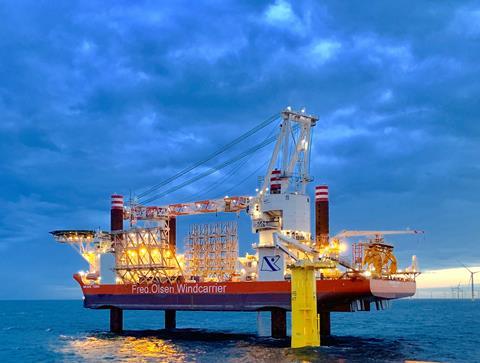Rystad Energy has warned that offshore wind installations could suffer bottlenecks from 2024 as demand outpaces the supply of capable vessels.

An ongoing trend in the offshore wind energy sector is the growing size of the turbines. Alongside that is an increasing demand for renewable energy. Soon the installation market could struggle to keep up with the demand of this ’super-sized’ offshore wind sector.
Operators will have to invest in new vessels or upgrade existing ones to install the super-sized turbines that are expected to become the norm by the end of the decade, or the pace of offshore wind installations could slow down, said Rystad.
Wind turbines globally, excluding China, have experienced a growth spurt in recent years, rising from an average of 3 MW in 2010 to 6.5 MW today, with the largest in operation clocking in at 10 MW. Turbines larger than 8 MW accounted for just 3 percent of global installations between 2010 and 2021, but that percentage is forecast to surge to 53 percent by 2030.
As the energy transition accelerates, demand for offshore wind turbine installation vessels worldwide, excluding China, will rocket from 11 vessel years in 2021 to almost 79 vessel years by 2030. The need for installation vessels for turbines larger than 9 MW, which was non-existent in 2019, will grow significantly by the end of the decade and reach 62 vessel years in 2030.
“When turbines were smaller, installation could be handled by the first-generation fleet of offshore wind vessels or converted jack-ups from the oil and gas industry. However, as operators continue to favour larger turbines, a new generation of purpose-built vessels is required to meet demand,” said Martin Lysne, Rystad Energy rigs and vessels analyst.
Unable to install new and larger turbines, the first-generation installation fleet has now transitioned into maintenance and repair services for installed turbines, while operators have upgraded other vessels’ cranes in order to remain competitive in the installations market.
Larger turbine installations require stronger cranes on installation vessels to lift heavier materials higher, and only a handful of purpose-built vessels available worldwide can install 10 MW-plus turbines. As a result, Rystad said, many vessels have moved from Europe to China, where lower crane capacity vessels are still in high demand.
For example, Jan De Nul’s Taillevent was sold to China last year, and DEME’s Apollo has also recently been renamed and reflagged to work in the Chinese market.
Out of the current fleet of purpose-built vessels, none are currently able to install 14 MW-plus turbines. This will change towards 2025 as newbuilds start to be delivered and existing vessels get crane upgrades. Fred Olsen Windcarrier, DEME and Cadeler are all planning crane upgrades, with Bold Tern, Brave Tern, Sea Installer, Wind Osprey and Wind Orca all upgrading to 1,600-tonne capacity cranes between 2022 and 2024.
In addition to the purpose-built vessels, some semi-submersible heavy lift vessels are being proposed for turbine installation, such as Heerema Marine Contractors’ Thialf and Sleipnir. Generally considered too large and inefficient for installing the smaller turbines of the past, these vessels have instead landed work in the offshore wind industry installing substations and heavy foundations. However, as the size of turbines increases, these units will fit right into the large cranes of heavy lift vessels such as Thialf and Sleipnir.
Thialf will install 27 turbines – each measuring 9.5 MW – at the Arcadis Ost wind farm in the Baltic Sea in 2023, becoming the first floating vessel to install commercial wind turbines of this size. Heerema has said both the Thialf and Sleipnir are already capable of installing 15 MW-plus turbines and, with some adjustments, these vessels could even install 20 MW turbines.
















